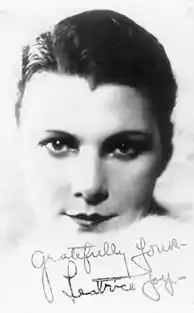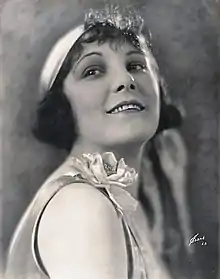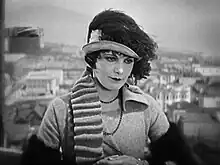Leatrice Joy | |
|---|---|
 Joy c. 1920 | |
| Born | Leatrice Johanna Zeidler November 7, 1893 New Orleans, Louisiana, U.S. |
| Died | May 13, 1985 (aged 91) New York City, U.S. |
| Resting place | Saint Savior Episcopal Churchyard |
| Other names | Beatrice Joy |
| Occupation | Actress |
| Years active | 1915–1954 |
| Spouses | William S. Hook
(m. 1931; div. 1944)Arthur Kem Westermark
(m. 1945; div. 1954) |
| Children | 1 |
Leatrice Joy (born Leatrice Johanna Zeidler;[1] November 7, 1893 – May 13, 1985) was an American actress most prolific during the silent film era.
Early life
Joy was born in New Orleans, Louisiana to dentist Edward Joseph Zeidler,[2] who was of Austrian and French descent, and Mary Joy Crimens, who was of German and Irish descent. She had a brother, Billy, who later worked at Metro-Goldwyn-Mayer.
She attended the Convent of the Sacred Heart in New Orleans, where she had planned on becoming a nun, but left when her father was diagnosed with tuberculosis and was forced to give up his dental practice. She tried out for the New Orleans-based Nola Film Company in 1915 and was hired as an actress. Her mother disapproved of her becoming an actress, but the family needed the money, so her mother accompanied her to California, where she began working in plays and films.[3][4]
Career
Silent films

Joy began her acting career in stock theater companies and soon made her film debut; between April 1916 and November 1917, she was the star of about 20 one-reel Black Diamond Comedies produced by the United States Motion Picture Corporation in Wilkes-Barre, Pennsylvania, and released nationally by Paramount Pictures.[5] In many of these, she starred as Susie.
In late 1917 she relocated to the relatively young film colony in Hollywood, California and began appearing in comedy shorts opposite Billy West and Oliver Hardy. Signed under contract with Samuel Goldwyn Studios, her first role for the studio was in 1917's The Pride of the Clan opposite Mary Pickford. Her career quickly gained momentum, and by 1920 she had become a highly-popular actress with the filmgoing public and was given leading-lady status opposite such performers as Wallace Beery, Conrad Nagel, Nita Naldi, and Irene Rich.

Directors often cast Joy in the strong-willed independent woman role, and the liberated atmosphere of the Jazz Age Roaring Twenties solidified her public popularity, especially with female movie goers. Her close-cropped hair and somewhat boyish persona (she was often cast as a woman mistaken for a young man) became fashionable during the era. With her increasing popularity, Joy was sought out by Cecil B. DeMille, who signed her to Paramount Pictures in 1922, immediately casting her in that year's successful high-society drama Saturday Night opposite Conrad Nagel. Joy starred in a number of successful releases for Paramount and was heavily promoted as one of DeMille's most prominent protégées.
In 1925, against the advice of studio executives, Joy parted ways with Paramount and followed DeMille to his new film company Producers Distributing Corporation, for which she made a few moderately successful films, including Lois Weber's last silent film The Angel of Broadway in 1927. After Joy impulsively cut her hair extremely short in 1926, DeMille was publicly angry as it prevented her from portraying traditional feminine roles.[6] The studio developed projects to promote the “Leatrice Joy bob” which she wore in Made for Love, Eve's Leaves, The Clinging Vine, For Alimony Only, and Vanity.[6] Although she regrew her hair after styles changed in early 1927, a professional dispute ended the DeMille/Joy partnership in 1928, and she was signed with MGM. That year, she headlined MGM's second part-talkie effort, The Bellamy Trial opposite Betty Bronson and Margaret Livingston.
Transition to sound
Joy's career began to falter with the advent of talkies, possibly because her heavy Southern accent was considered unfashionable in comparison with other actresses' refined "Mid-Atlantic" diction. In 1929, she became a freelance actress without a long term contract. In order to improve her chances of regaining her film career, she undertook a vaudeville tour from 1929 to 1931, as a training ground for returning successfully to talkies. She was particularly interested in improving her voice and learning how to better handle dialogue.
Retirement and later years
By the early 1930s, Joy was semi-retired from the motion-picture industry, but she later made several guest appearances in a few modestly-successful films, such as 1951's Love Nest, which featured a young Marilyn Monroe.
In the 1960s, Joy retired to Greenwich, Connecticut, where she lived near her daughter and son-in-law.[7]
Joy appeared as a subject on the game show To Tell the Truth on July 1, 1963.
She was interviewed in the television documentary series Hollywood: A Celebration of the American Silent Film (1980).[8]
Personal life
Joy was married three times and had one child. On March 22, 1922, she married actor John Gilbert. They had a daughter, Leatrice,[9][10] who later acted in bit parts; she was the first wife of novelist and playwright Ernest Gébler.[11][12] Joy filed for divorce in August 1924, citing Gilbert's infidelity and alcoholism.[13][14] Joy's second marriage was to businessman William Spencer Hook on October 22, 1931;[15] they divorced in 1944. Joy's third and final marriage was to former actor and electrical engineer Arthur Kem Westermark. They married on March 5, 1945, in Mexico City and divorced in October 1954.[16][17]
During her silent film career in the 1920s, she was Hollywood's best known Christian Scientist.[18]
Death
On May 13, 1985, Joy died from acute anemia at the High Ridge House Christian Science nursing home in Riverdale, Bronx, New York.[19][20] She was interred at the Saint Savior Episcopal Churchyard in Old Greenwich, Connecticut.
For her contribution to the motion picture industry, Leatrice Joy has a star on the Hollywood Walk of Fame at 6517 Hollywood Blvd. in Hollywood, California.[21]
Filmography
| Year | Title | Role | Notes |
|---|---|---|---|
| 1915 | His Turning Point | Mrs. Carey | |
| 1916 | The Folly of Revenge | Antonio's Daughter | |
| The Other Man | short film | ||
| A Troublesome Trip | unconfirmed role | short film | |
| Their Counterfeit Vacation | unconfirmed role | short film | |
| Auto Intoxication | short film credited as Beatrice Joy | ||
| 1917 | Excess Baggage | Sue Topper | short film |
| The Pride of the Clan | Extra | uncredited | |
| A Girl's Folly | Girl | uncredited | |
| Her Scrambled Ambition | Susie | short film | |
| The Magic Vest | short film credited as Beatrice Joy | ||
| Speed | short film credited as Beatrice Joy | ||
| Getting the Evidence | short film credited as Beatrice Joy | ||
| The Wishbone | short film credited as Beatrice Joy | ||
| Her Iron Will | short film credited as Beatrice Joy | ||
| Her Fractured Voice | short film credited as Beatrice Joy | ||
| Susie of the Follies | Susie | short film credited as Beatrice Joy | |
| The Window Dresser's Dream | short film credited as Beatrice Joy | ||
| Wits and Fits | short film credited as Beatrice Joy | ||
| The Rejuvenator | short film credited as Beatrice Joy | ||
| Susie the Sleepwalker | Susie | short film credited as Beatrice Joy | |
| Susie's Scheme | Susie | short film credited as Beatrice Joy | |
| Susie Slips One Over | Susie | short film credited as Beatrice Joy | |
| The Candy Kid | short film | ||
| Nearly a Baker | short film credited as Beatrice Joy | ||
| A Society Scrimmage | short film credited as Beatrice Joy | ||
| The Slave | Susie, his daughter | short film lost film | |
| 1918 | The Stranger | Susie | short film |
| His Day Out | Joy | short film | |
| The Orderly | short film | ||
| The Scholar | short film | ||
| The Messenger | short film | ||
| The Handy Man | short film | ||
| Shackled | Undetermined role | uncredited/unconfirmed | |
| One Dollar Bid | Emily Dare | ||
| The City of Tears | Maria | lost film | |
| Wedlock | Jane Hollister | ||
| Her Man | alternative titles: The Battle Cry The Woman Eternal | ||
| Three X Gordon | Farmer's Daughter | ||
| 1919 | The Man Hunter | Florence | lost film |
| The Water Lily | undetermined role | ||
| 1920 | Just a Wife | Mary Virginia Lee | |
| The Right of Way | Rosalie Eventurail | lost film | |
| Blind Youth | Hope Martin | lost film | |
| Smiling All the Way | Alice Drydan | ||
| The Invisible Divorce | Pidgie Ryder | lost film | |
| Down Home | Nance Pelot | ||
| 1921 | Bunty Pulls the Strings | Bunty Biggar | lost film |
| A Tale of Two Worlds | Sui Sen | ||
| The Ace of Hearts | Lilith | ||
| Ladies Must Live | Barbara | lost film | |
| The Poverty of Riches | Katherine Colby | lost film | |
| Voices of the City | Georgia Rodman | lost film | |
| 1922 | Saturday Night | Iris Van Suydam | |
| The Bachelor Daddy | Sally Lockwood | lost film | |
| A Trip to Paramountown | Herself | short film | |
| Manslaughter | Lydia Thorne | ||
| The Man Who Saw Tomorrow | Rita Pring | lost film | |
| Minnie | Minnie | lost film | |
| 1923 | Java Head | Taou Yuen | lost film |
| You Can't Fool Your Wife | Edith McBride | lost film | |
| The Silent Partner | Lisa Coburn | lost film | |
| Hollywood | Cameo role | lost film | |
| The Ten Commandments | Mary Leigh | ||
| 1924 | The Marriage Cheat | Helen Canfield | incomplete |
| Triumph | Ann Land | ||
| Changing Husbands | Gwynne Evans/Eva Graham | ||
| 1925 | The Dressmaker from Paris | Fifi | lost film |
| Hell's Highroad | Judy Nichols | ||
| The Wedding Song | Beatrice Glynn | ||
| 1926 | Made for Love | Joan Ainsworth | |
| Eve's Leaves | Eve Corbin | ||
| The Clinging Vine | Antoinette B. "A.B." Allen | ||
| For Alimony Only | Mary Martin Williams | ||
| 1927 | Girl in the Rain | ||
| Nobody's Widow | Roxanna Smith | ||
| Vanity | Barbara Fiske | ||
| The Angel of Broadway | Babe Scott | lost film | |
| 1928 | The Blue Danube | Marguerite | |
| Man-Made Women | Nan Payson | ||
| Show People | Herself - at Banquet | uncredited | |
| Tropic Madness | Juanita | Lost film, except for 14 minutes discovered in 2022 | |
| 1929 | The Bellamy Trial | Sue Ives | |
| Strong Boy | Mary McGregor | lost film | |
| A Most Immoral Lady | Laura Sergeant | ||
| 1930 | The Love Trader | Martha Adams | |
| 1939 | First Love | Grace Shute Clinton | alternative title: Cinderella |
| 1940 | The Old Swimmin' Hole | Mrs. Julie Carter | |
| 1949 | Red Stallion in the Rockies | Martha Simpson | |
| Air Hostess | Celia Hansen | ||
| 1951 | Love Nest | Eadie Gaynor | |
| 1953-1954 | Westinghouse Studio One | various roles | 2 episodes |
| 1954 | Robert Montgomery Presents | episode: "The Steady Man" | |
References
- ↑ "New Orleans, Louisiana Birth Records Index, 1790-1899". Vital Records Indices. State of Louisiana, Secretary of State, Division of Archives, Records Management, and History. 101: 520. 2002.
- ↑ Soard's New Orleans, Louisiana 1913 City Directory. Association of American Directory Publishers. 1913. p. 1228.
- ↑ Motion Picture. Macfadden-Bartell. 28: 27.
{{cite journal}}: Missing or empty|title=(help) - ↑ Wayne, Jane Ellen (2006). The Leading Men of MGM. Da Capo Press. p. 84. ISBN 0-786-71768-8.
- ↑ "Leatrice Joy in Paramount Comedies". The Moving Picture World: 2084. June 30, 1917. Retrieved December 12, 2012.
- 1 2 Johanna, Schmertz (2013), "The Leatrice Joy Bob: The Clinging Vine and Gender's Cutting Edge", in Dall’Asta, Monica; Duckett, Victoria; Tralli, Lucia (eds.), Researching Women in Silent Cinema: New Findings and Perspectives, University of Bologna, pp. 402–13, ISBN 978-8-8980-1010-3, ISSN 2283-6462
- ↑ "Former Film Star Ends Stay at Beach". The Los Angeles Times. May 24, 1962. p. F14.
- ↑ Brownlow, Kevin; Gill, David (1980). Hollywood: A Celebration of the American Silent Film (video). Thames Video Production.
- ↑ "Leatrice Fountain's Obituary on GreenwichTime". GreenwichTime.
- ↑ "Leatrice Gilbert Fountain (1924-2015): Daughter of Hollywood Legends". January 25, 2015.
- ↑ "Son reveals Edna O'Brien's rows with jealous husband".
- ↑ LaSalle, Mick (July 6, 2005). "Saved from ignominy/His daughter's stubborn campaign put unfairly maligned actor John Gilbert back in the pantheon of silent film stars -- where he's always belonged". sfgate.com. Retrieved January 6, 2016.
- ↑ "Leatrice Joy Asks Divorce". The Telegraph-Herald. August 3, 1924. p. 22. Retrieved February 12, 2013.
- ↑ Arnold, Thomas K. (March 23, 1988). "Symphony to Screen John Gilbert Classic Daughter Speaks Up About a Silent Legend". The Los Angeles Times. p. 1.
- ↑ "Leatrice Joy Has New Role; Through With Film Career". The Telegraph-Herald and Times-Journal. October 22, 1931. p. 1. Retrieved February 12, 2013.
- ↑ "Leatrice Joy Wed Electrical Engineer". The Evening Independent. March 14, 1945. Retrieved February 12, 2013.
- ↑ "Leatrice Joy Divorced". The New York Times. October 22, 1954. p. 24.
- ↑ Anthony Slide (2005). "Christianity Hollywood Style: Reverend Neal Dodd". Silent Topics: Essays on Undocumented Areas of Silent Film. Scarecrow Press. p. 31. ISBN 0810850168.
In the 1920s, actress Leatrice Joy was Hollywood's best known Christian Scientist; in the 1930s it was Jean Harlow
- ↑ "Leatrice Joy, 91, Dies; Actress in Silent Films". The New York Times. May 18, 1985.
- ↑ "Featured in DeMille's 'The Ten Commandments' : Silent Film Star Leatrice Joy Dies at 91". The Los Angeles Times. May 15, 1985. Retrieved January 27, 2014.
- ↑ "Hollywood Star Walk". Los Angeles Times. Retrieved February 12, 2013.
External links
- Leatrice Joy at IMDb
- Leatrice Joy at Silents Are Golden
- Leatrice Joy at Silent Era People
- Leatrice Joy at Silent Ladies & Gents
- Leatrice Joy at The International Silent Movie
- Leatrice Joy at Virtual History